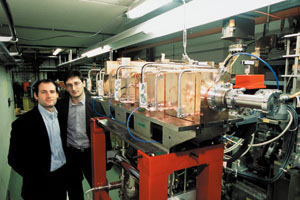
A new linear accelerator is on course to bring about important advances in cancer therapy following
successful tests at CERN last year. The LIBO Linac Booster was conceived in 1993 by Ugo Amaldi (then
a member of CERN staff), who instigated the Terapia con Radiazion Adroniche (TERA) Foundation to
promote the development of cancer therapy using hadron beams.
The LIBO project, led by TERA’s
Mario Weiss (also formerly of CERN), aims to build a proton linear accelerator to boost the energy of
beams extracted from existing 50-70 MeV cyclotrons to 200 MeV. Many such cyclotrons are already used
in nuclear research for isotope production, and for the proton therapy of superficial eye melanomas. The
addition of a linac booster would allow the treatment of deep-seated tumours where higher energies are
needed.
The main challenge for the LIBO team was to make the linac sufficiently compact. This
requires high-frequency operation to achieve a large accelerating gradient. A frequency of 3 GHz was
chosen for a gradient of around 15 MV/m in the accelerating tanks. LIBO is the first proton linac of its
kind to be designed with such a high frequency and low injection energy.

A complete LIBO
accelerator will comprise nine modules, each consisting of four accelerating tanks, the lengths of which
increase to match the increasing velocity of the accelerated protons. The length will be just 15 m and the
average gradient 10 MV/m for a modest power consumption of around 80 kW.
LIBO’s beam
aperture is only 8 mm, which leads to an additional challenge for beam transfer. This is overcome by
focusing the beam with 36 identical permanent quadrupole magnets – four per module. Cyclotrons are
direct-current machines, whereas LIBO is pulsed with a 0.2% duty cycle. In DC operation it would
capture only 10% of the beam, but, as proton therapy does not require high currents, this is
sufficient.
Excessive irradiation of LIBO will be avoided by pulsing the cyclotron source. LIBO’s
resulting beam structure, with 2.5 ms between pulses, is well adapted to the active scanning techniques
currently used in proton therapy to deliver precisely measured doses to each three-dimensional pixel of a
tumour.
The first stage in the LIBO project was to build and test the first module of the accelerator,
which will accelerate protons from 62 to 74 MeV. A decisive step was taken in 1998 when a collaboration
was established between TERA, CERN (Ettore Rosso et al.) and the universities and INFN
sections of Milan (Carlo De Martinis et al.) and Naples (Vittorio Vaccaro et al.). With help
from CERN, LIBO’s copper accelerating structure was designed and the module was built in CERN’s
workshops. It was installed at CERN last November and power-tested using a spare 3 GHz klystron from
the LEP electron linac. After a period of conditioning, an average gradient of nearly 30 MV/m – well in
excess of the design requirement – was achieved in each tank of the module.
The next step is to
move the module to the INFN laboratories in Catania, where it will be coupled to a superconducting
cyclotron to provide it with a proton beam of 62 MeV. The LIBO collaboration has teamed up with
Belgian company IBA – the world’s foremost supplier of medical cyclotrons – and its Swedish subsidiary,
Scanditronix Wellhöfer, to use one of their 3 GHz modulators in Catania. This collaboration may lead to
the creation of a consortium to oversee the longer-term development of the accelerator technology. The
LIBO collaboration is also looking for another industrial partner to develop the diagnostic instrumentation
that would be needed at a LIBO-based proton therapy centre.








